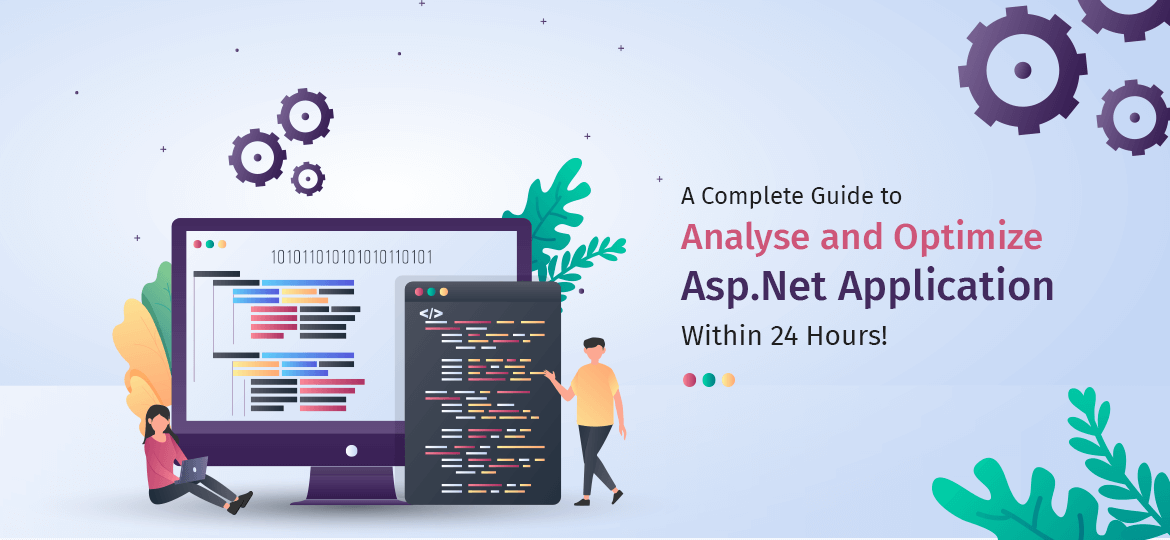
Just imagine. It’s Friday evening and the majority of your developers are heading away towards the weekend. You too are packing up your things and soon you start getting alerts from your monitoring system: Something is broken and soon all the evidence points towards the application performance degradation.
So, what can be done to prevent the poor-performing code towards the final development round?
Well, this experience is quite common for the majority of the .Net developers and the software development team and all a .Net development company can do is validate the aspects that have negative impacts on the optimize net application performance.
This article focuses on .Net performance optimization workflow that measures app performance, diagnoses the potential issues faced and validates the effectiveness of its improvement. It’s an iterative process of discovering, profiling, testing, and monitoring the app development that follows proper quality assurance guidelines.
So, without wasting much time, let’s get started with the ways to optimize the .net application.
What’s in the process of ASP.Net performance optimization?
There are several ways to improve the performance of an application written using the.NET Framework. These techniques include improving the efficiency of code execution, reducing memory usage, and optimizing database access.
Below is the process followed by Asp.Net MVC development companies to optimize .Net applications at the highest level.
1. Code Reviews
Undergoing code review is highly essential for any Asp.Net core development company so as to enforce quality control over code before it reaches its production level. Reviewing code allows team members to acknowledge changes in the code and use their judgment to approve or suggest changes in their work.
Though reviewing code can seem to be a time-consuming process; its thoroughness is rarely communicated to the team. So make sure to communicate the issues thoroughly so as to ensure the best code practices in software development.
2. Discovery of Performance Issues
Several application performance management tools including Retrace and Prefix can be used to identify the poorly performing application, its flaw points, breakpoints, etc at a high level. Conducting such an investigation helps developers with the local discovery of performance issues and thus narrow down the focus before opting for a more detailed profiling utility.
3. Staging Environment
Though prefix is a great tool to identify performance errors in the local development environment, it is really impractical to reproduce the same development scenarios locally. In such a case, tools like Retrace would work best at leveraging the same kind of development environment deployment remotely.
Its deployment tracking feature also helps you to identify the performance issues caused while changing the application code.
4. Profiling
Well, there are several different types of profiling options including Visual Studio, JetBrains dot Trace, and dot memory. Amongst these, one of the most consistently worked profilers with .Net core was the Visual studio performance profiler while debugging.
If you want to opt for any profiler, your approach highly depends upon your application type. For a long-run app with a constant workload, you can get quick behavioral insights from CPU and memory charts. The profiler will help you to identify where you’re spending more time and thus will help you with better .Net performance optimization.
5. Benchmarking
Benchmarking is one of the most crucial and critical steps while making performance improvements. Without benchmarking, it becomes hard for developers to validate the performance impact on our changes. To perform this, BenchmarkDotNet is one of the best tools and even Asp.net companies make use of it for writing benchmarks.
How to optimize ASP.Net performance?
Below are some of the practices followed to optimize .Net performance at its peak.
1. Identify Bottlenecks
Identifying bugs and clutters in your .Net application is the first step towards optimization. Some of the most common issues that can affect your running .Net application are an improper rendering of HTML, thread pool issues, complex algorithms, etc due to long-running operations. It is advisable to identify the bottlenecks and resolve them to ensure high-speed app performance.
2. Remove unused Modules
In the Asp.Net application, requests get processed once they’ve passed multiple HTTP modules and finally reach the handler which serves the request. To boost the performance, you need to run a code to check the list of active modules and the ones that are unused. You need to shorten the request pipeline to ensure quick results. For removing any particular module, you need to update your web. config.
3. HTTP Compression
One of the best ways to optimize the .net app performance is HTTP compression. It works by compressing almost everything in the GZip format before transmitting the data to the wire. HTTP compression can be static and dynamic. Make sure to compress everything before getting started.
4. Load balancer
The apps that receive more traffic are benefitted from the load balancer. It will act as a point of receiving client requests as per the load balance algorithm and will forward it to the server which will be less loaded based on its state.
5. Utilize caching
You can optimize your ASP.Net website by making caching ON. Enabling caching will be helpful in rendering the stored copy of the page in the memory and thus will give a boost in performance. Work with VaryBy and SqlDependency parameters to ensure that your cache increases speed without affecting performance.
Conclusion
ASP.NET applications leverage an endless number of possibilities for developers. At the same time, there are several areas where they can be optimized. Performance optimization is not a one-way process but an iterative relationship between .Net developer and the application. Understanding problems is quite essential as uncertain steps can lead to unwanted ripples in different areas of the application. Be ready to repeat processes and invest enough time to analyze and get closer to the goal of an optimized .NET application.
If you’re looking forward to optimizing the Asp.Net app, Concetto labs can help you. We house a team of professional and experienced developers that have developed 100+ scalable and high-performing apps that will surely give you value for money. Contact us now to optimize your app today.









 Indonesia
Indonesia
 Botswana
Botswana
 USA
USA
 Italy
Italy
 Panama
Panama









 USA
USA UK
UK Saudi Arabia
Saudi Arabia Norway
Norway India
India Australia
Australia